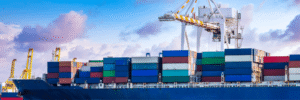The largest container ports in Asia – TOP 15
Container ports in Asia are one of the most important links in the international supply chain. Thanks to their location and wide range of activities, they account for a significant part of global transhipments, ensuring the uninterrupted flow of goods between the world’s largest economies. It is here that the most important sea routes intersect, handling, among other things, exports from Asian factories and imports of raw materials from all over the world.
In this article, we present a ranking of the TOP 15 largest container ports in Asia, based on data for 2024. Find out which ones dominate in terms of transhipment volume, where we are seeing the fastest growth and which ports are strengthening their position in international logistics.
The role of Asian container ports in international transport
From the ports on the Yellow Sea to the terminals in the Persian Gulf, Asia’s container infrastructure impresses with its scale and pace of development. The role of Asian container ports in global transport is growing year by year.

Asia can, without hesitation, be called the global centre of maritime transport, and its container ports the cornerstone of global trade. It is home to the largest and busiest container terminals in the world, handling millions of TEUs annually and ensuring the efficient flow of goods between continents. Their strategic location along major shipping routes ensures effective connections with Europe, the Americas, Africa and the Middle East.
Seaports in Asia are not only container transhipment points, but also advanced logistics centres that support global supply chains. Thanks to modern port terminals, integration with land transport, process automation and the handling of both consumer goods and raw materials, including crude oil and petroleum products, they play an extremely important role in the development of shipping, freight forwarding and warehousing services.
In the face of current geopolitical tensions and market disruptions, Asian seaports are not losing their importance. Their extensive infrastructure, flexibility and investment in technology mean that they maintain their reputation as some of the most modern container ports in the world.
Read also: The largest container ports in Europe – TOP 15 >>>
TOP 15 – The largest container ports in Asia
Asia’s largest container ports are hubs that handle millions of tonnes of goods every day. Find out which ones had the biggest impact on international transport in 2024.

#1 Port of Shanghai (China)
51,51 mln TEU (source)
The Port of Shanghai, operating since 1842, is the largest and busiest container port in Asia – and in the world. In 2024, over 51.5 million TEU were handled here, representing an increase of 4.77% compared to the previous year. This impressive result reinforces its extremely important position as a key link in international logistics.
The port area of Shanghai, located at the mouth of the Yangtze River, covers more than 3,600 km². Thanks to extensive automation and continuous investment, it has one of the most efficient transhipment infrastructures in the world. The port’s flagship facility is the industry’s largest automated container terminal, Yangshan Deep-Water Port, which is recognised as a global benchmark for operational efficiency.
Official website of the Port of Shanghai (in Chinese) >>>
#2 Port of Singapore (Singapore)
40,9 mln TEU (source)
The second busiest port in our ranking is the Port of Singapore, with a container transhipment volume of 40.9 million TEU in 2024, representing a 5.5% increase year-on-year.
The Port of Singapore was the world leader in container traffic for many years before giving way to the Port of Shanghai. Today, it remains one of the most important links in global maritime trade. Located at the southern entrance to the Singapore Strait, it plays a key role as a transhipment hub on routes between Asia, Europe and America.
Official website of the Port of Singapore >>>
#3 Port of Ningbo-Zhoushan (China)
39,30 mln TEU (source)
The Port of Ningbo-Zhoushan is the third largest container port in the region. In 2024, it handled 39.3 million TEU, an increase of 11.3% compared to 2023.
It is located on the coast of the East China Sea, near the economically developed Yangtze River Delta. With its advanced infrastructure, modern container terminals and direct access to major Pacific trade routes, it plays a strategic role in global trade as a distribution point for goods to world markets.
Official website of the Port of Ningbo-Zhoushan >>>
#4 Port of Shenzhen (China)
33,4 mln TEU (source)
The Chinese Port of Shenzhen is growing in strength as a container handling centre in the region. This is evidenced by its 2024 transhipment result of 33.4 million TEU, representing a year-on-year increase of 11.78% – one of the highest among Asian ports.
Located in southern China, in the Pearl River Delta (Guangdong Province), the port has modern infrastructure that enables efficient management of mass industrial production. Every day, hundreds of shipping connections are made, supporting the export of Chinese goods to markets around the world.
Official website of the Port of Shenzhen >>>
#5 Port of Qingdao (China)
30,87 mln TEU (source)
Operating since 1892, Qingdao Port is one of China’s major seaports and the fifth largest container port in Asia. In 2024, it handled 30.87 million TEU, recording a 7.3% increase compared to 2023.
The port is located on the Yellow Sea in Shandong Province. It is a rapidly growing export hub in Northeast Asia and plays an important role in international trade with other regions of Asia, Europe and North America. Due to its strategic location between the Yangtze River Delta and the Bohai Rim region, the port of Qingdao plays a key role in the Maritime Silk Road.
Official website of the Port of Qingdao >>>
#6 Port of Guangzhou (China)
26,07 mln TEU (source)
The Port of Guangzhou (Port of Canton) is China’s oldest container port, located in the Pearl River Delta. In 2024, it handled 26.07 million TEU, 3.9% more than in the previous year.
As the main port on China’s south coast, Guangzhou provides comprehensive logistics services and effectively connects domestic production with foreign markets. Efficient infrastructure, growing transhipment capacity and intensive expansion mean that the port maintains a strong position in the international container transport system.
Official website of the Port of Guangzhou >>>
#7 Port of Busan (South Korea)
24,40 mln TEU (source)
The Port of Busan is South Korea’s largest container port. In 2024, it handled over 24.4 million TEU, up 5.4% year-on-year.
Operating since 1876, the port of Busan (also known as Busan Harbor) has developed from a small regional trading centre into a powerful logistics complex. Thanks to its modern infrastructure, it effectively integrates South Korea’s industry into the global supply chain. Almost the entire volume of industrial goods leaves the country through this port.
Official website of the Port of Busan >>>
#8 Port of Tianjin (China)
23,29 mln TEU (source)
In 2024, the Port of Tianjin handled 23.29 million TEU, which represents a 5.0% increase compared to the previous year. It is the largest container port in northern China.
The port is a key link connecting Beijing with international shipping routes – it is located about 170 km from the capital, on the Yellow Sea, which provides direct access to global trade for the entire capital region. Thanks to growing investment in infrastructure and modern logistics technologies, Tianjin is strengthening its position as one of the most important container ports in East Asia.
Official website of the Port of Tianjin >>>
#9 Port of Jebel Ali (United Arab Emirates)
15,5 mln TEU (source)
Located in the emirate of Dubai, Jebel Ali Port is the largest container port in the Middle East and the largest man-made seaport in the world. In 2024, container transhipments reached 15.5 million TEU, generating growth of 7.4% compared to the previous year.
It plays a key role as a link between Asia, Europe and Africa, serving as a hub for trade routes in the MENA (Middle East and North Africa) region. It comprises four modern container terminals and is one of the main stops on the Maritime Silk Road.
Official website of the Port of Jebel Ali >>>
#10 Port Klang (Malaysia)
14,64 mln TEU (source)
Port Klang is Malaysia’s largest container port, located on the west coast of the Malay Peninsula, about 40 km from Kuala Lumpur. In 2024, it handled 14.64 million TEU, representing an increase of approximately 4.12% year-on-year.
The port plays a key role in the country’s maritime trade, serving as the main link between Malaysia and global shipping routes. Thanks to its location in the Strait of Malacca and its modern container infrastructure, it is an important stop on the Maritime Silk Road. It serves as a strategic transhipment centre for Southeast Asia.
#11 Port of Hong Kong (China)
13,69 mln TEU (source)
The Port of Hong Kong has now left the top 10 largest Asian ports, but it is still one of the busiest container ports in the region. In 2024, it handled approximately 13.7 million TEU, a decrease of 4.9% compared to 2023.
Nine container terminals, concentrated in the Kwai Chung–Tsing Yi basin, account for over 75% of the total transhipment volume. These terminals are operated by five operators and are a key element of Hong Kong’s port infrastructure, ensuring high efficiency and operational performance on an international scale.
Official website of the Port of Hong Kong >>>
#12 Port of Tanjung Pelepas (Malaysia)
12,253 mln TEU (source)
The Port of Tanjung Pelepas, Malaysia’s second largest container port, handled 12.25 million TEU in 2024, an impressive increase of 16.9% over the previous year.
Operating since 1999, the port has quickly gained importance as a modern transhipment hub. Its location in the Strait of Johor and proximity to the Port of Singapore make it a strategic point on the main east-west shipping routes. Known for its high operational efficiency and extensive infrastructure, the port of Tanjung Pelepas plays an important role in the flow of goods between Asia and Europe.
#13 Port of Xiamen (China)
12,250 mln TEU (source)
The Port of Xiamen is located in the southern part of Fujian Province. In 2024, it handled 12.25 million TEU, recording a slight decline of 2.4% year-on-year. Nevertheless, it maintains its strong position as one of the major container ports in Asia.
As an important point on the Maritime Silk Road, Xiamen is a key link in China’s trade with Southeast Asia, the Middle East and Europe. The port’s modern infrastructure and deep-water terminals allow for the efficient handling of large volumes of cargo.
#14 Port of Laem Chabang (Thailand)
9,47 mln TEU (source)
Thailand’s largest container port, Laem Chabang, handled nearly 9.47 million TEU in 2024, representing a 9.2% increase in terms of transhipment volume. Located 130 kilometres south of Bangkok, it plays a key role in serving the country’s maritime trade.
Since its inception in 1991, Laem Chabang has grown rapidly, attracting industrial investment and supporting exports from Thailand to markets in Asia, Europe and the Middle East. Thanks to its deep-water terminals and the development of cooperation between the public sector and private operators, the port is effectively increasing its transhipment capacity and importance in the South-East Asia region.
#15 Port of Kaohsiung (Taiwan)
9,23 mln TEU (source)
The Port of Kaohsiung is Taiwan’s largest container port and one of the key maritime hubs in the western Pacific. In 2024, it handled nearly 9.23 million TEU, which translates into a 4.47% increase compared to the previous year.
Located on the south-western coast of the island, at the junction of the Taiwan Strait and the Bashi Channel, Kaohsiung Port has extensive infrastructure and a favourable terrain. As a central point for maritime transport in Taiwan and an important hub for East Asia, it is constantly investing in the development of digital systems and automation of services to increase its efficiency and competitiveness.
Official website of the Port of Kaohsiung >>>
The above TOP 15 ranking confirms the important role played by Asian container ports in the modern world of international transport. They set the pace for global maritime logistics, which is why it is worth keeping track of their development, investments and the technologies they implement.
Summary
Asia has been a leader in global maritime transport for years, and its container ports set the standard in terms of scale, efficiency and modern logistics solutions. The ranking of the largest container ports in Asia for 2024 shows how important they are in international trade, both as transhipment points and advanced supply chain management centres.
Many of them are constantly developing their infrastructure, automating processes and adapting to changing market realities. As a result, regardless of changes in the global economy, it is Asia that continues to set the direction for the future of container shipping.
Frequently asked questions (FAQ)
What are the largest container ports in China?
The largest container ports in China are: Port of Shanghai, Port of Ningbo-Zhoushan, Port of Shenzhen, Port of Qingdao, Port of Guangzhou, Port of Tianjin, Port of Hong Kong (located in a special administrative region), Port of Xiamen, Port of Dalian, Yingkou Port, Rizhao Port, Nantong Port, Basuo Port, Haikou Port, Nanjing Port and Lianyungang Port.
What are the most important container ports in the world?

The most important container ports in the world are those that handle the largest volume of transhipments, have modern infrastructure and are strategically located in the global supply chain.
The vast majority of them are located in Asia, including the Port of Shanghai, Port of Singapore, Port of Ningbo-Zhoushan, Port of Shenzhen, Port of Busan and Port of Hong Kong, which we have described in detail in the article. It is also worth mentioning smaller Asian ports that are constantly growing in strength, such as the Chinese Port of Taicang, the Port of Tanjung Priok in Indonesia, the Port of Manila and the Port of Colombo in Sri Lanka.
European ports such as the Port of Rotterdam, the Port of Antwerp-Bruges and the Port of Hamburg, located in the immediate vicinity of the North Sea, are also of key importance, as are ports in North America, especially the Port of Los Angeles and the Port of Long Beach, which form the largest container complex on the west coast of the United States.
Why are container transhipments in seaports measured in TEU?
TEU (Twenty-foot Equivalent Unit) is a standard unit of measurement in container transport, corresponding to one container with a length of 20 feet. It is used to compare the throughput of ports and fleets, which standardises data regardless of the size of individual containers.
You can read more about TEU in the article: What are TEU and FEU? Application and main differences >>>